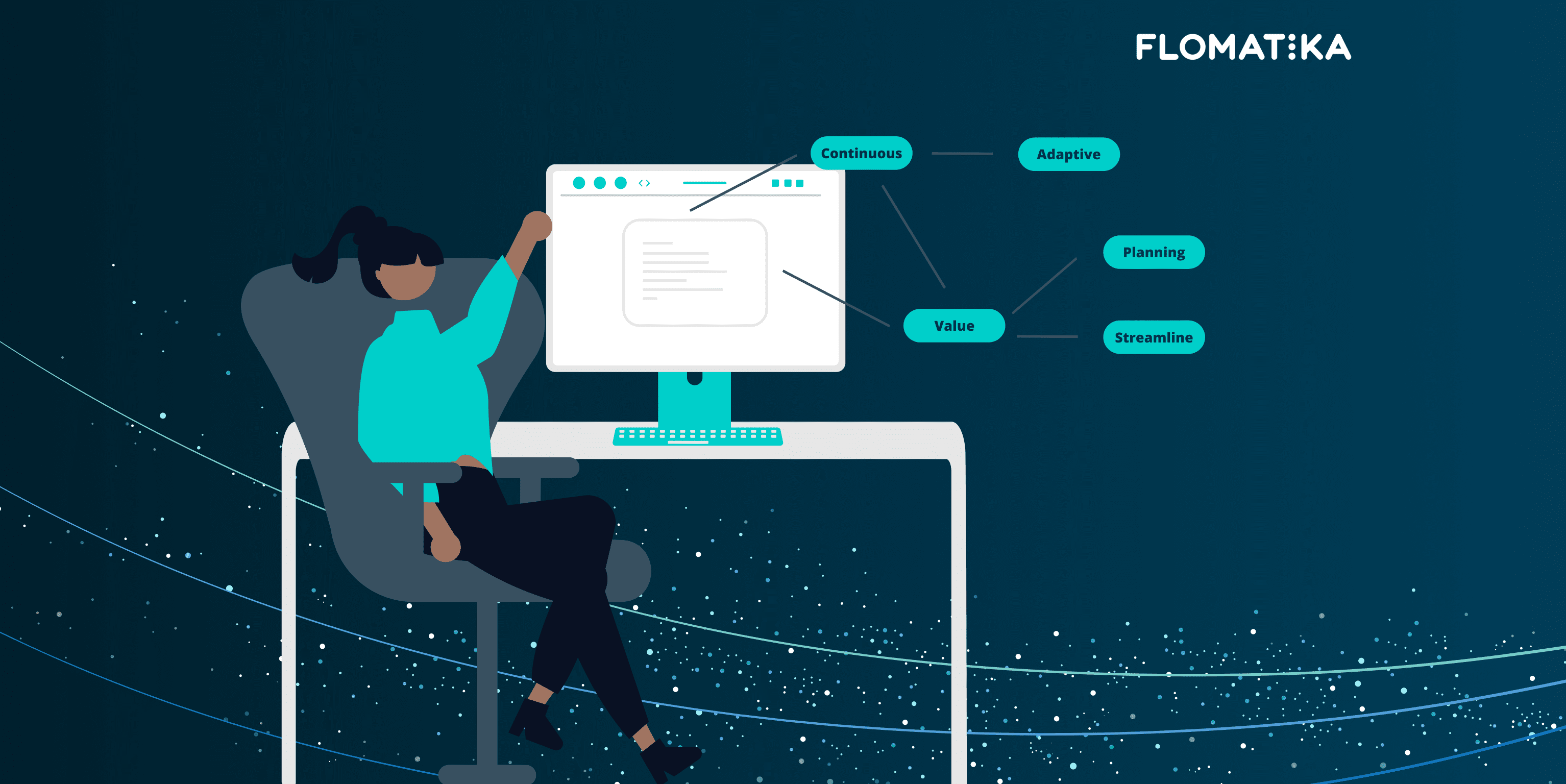What does a Value Stream Manager do?
.jpeg)
Are you ready to optimise your delivery ecosystem today?
book demoWhat does a Value Stream Manager do?
Focus:
- The end-to-end view of the Value Stream
- Has the lens of both efficiency and effectiveness (combining flow awareness, customer awareness and business strategy
- Works at the macro level, supporting teams and segments in working together
Differentiator: Works at the macro level and combines both the business/customer view along with flow-awareness
Related Roles: Service Delivery Manager, Service Request Manager
Similar Roles: Delivery Manager, RTE
Once again we need to add the same preface as the previous two blogs on the Service Delivery Manager and Service Request Manager. From what we’ve seen, this is another emergent role. It’s still new to the industry, with different organisations approaching the role differently. This is not meant to be a definitive guide. It's us sharing our observations, along with our views on how we see the role evolve.
Before we talk about what they do, we firstly need to talk about Value Streams.
Value Streams
In a nutshell, if you connect someone with a need, to a product or service that can fulfil that need, you have a Value Stream!
Value Streams can take on many different forms, but within this context, we’re talking about Enterprise Value Streams. For large organisations to be able to satisfy their customer needs, they require Value Streams that are made up of many many people. They are typically made up of multiple Value Stream Segments. As such they usually require some level of handovers and coordination between these segments. There are also Supporting Value Streams Segments, which often take the form of specialist teams, who potentially have many touch points across the Value Stream.

Another type of value stream segment can take the form of external vendors. For large Enterprises, getting value from request through to delivery to the customers can be quite long and complex. Needing to go through the various value stream segments.
So What Does a Value Stream Manager Do?
This is where the Value Stream Manager comes in. Someone who has accountability across the entire Value Stream. Ensuring the work efficiently flows through the Value Stream, across all the Value Stream Segments, managing the dependencies between them, minimising the time spent in waiting between them. They also need to have a strong understanding of their customer and their needs, to then be able to ensure that the Value Stream is effectively fulfilling these needs.
A Role at Scale
This role is only required due to the large size of some Value Streams. If you are able to satisfy your customer needs through individual services, run by single teams, then there really isn’t a need for a Value Stream Manager. However, with more complex services, especially those provided by large Enterprises, Value Streams can be quite complex, made up of several teams that all need to work together to deliver value to their customers.
“The Value Stream Manager is on that top level, looking at customer needs and outcomes. Not output.”
~ Marcio Sete, CPTO of Flomatika
The need for this role comes about when you need someone to sit across the end to end of the Value Stream to provide leadership, provide alignment on strategy, to set the thresholds of the fitness criteria of the Value Stream, to coordinate across the various Segments in the Value System.
The Value Stream Manager doesn’t necessarily do this alone. They are likely to be interacting with several Service Request Managers and Service Delivery Managers in order to ensure that the whole Value Stream end to end is functioning properly.
The individual Service Delivery Managers and Service Request Managers work much closer to the individual flow units level. Depending on the size and complexity of their value stream, they might not have that clear vision of the customer needs. How each of their individual services are working together to satisfy their customer needs. This is where the Value Stream Manager’s role comes into play. To be able to pull everything together, across all the segments and teams to ensure the end-to-end is both effective and efficient.

Fit for Purpose
The Value Stream Manager should constantly be asking questions, and then pursuing fitness for purpose. Is the Value Stream fit enough to fulfil my customer needs?
These questions can come in the form of:
- Who are my customers? (Has it changed?)
- Are we satisfying the customer's needs? (What are the success criterias?)
- What are the types of demands? (Do the different demands have different criterias?)
- When are we able to deliver on these demands?
- At what quality level do we need to deliver? (What’s the minimum acceptable level? Are we over delivery in some aspects therefore sacrificing in others? Eg over delivering in quality to the detriment of speed.)
- What are our predictability levels? (Do we have predictable delivery rates? Do we have predictable delivery times?)
- What’s the selection criteria for a demand to be actually picked up and worked on?
Ultimately asking: Is my Value Stream fit for purpose? What are the acceptable thresholds to stay fit for purpose?
Key Qualities of a Value Stream Manager
Mix of SDM and SRM
“You need qualities of both the Service Delivery Manager and the Service Request Manager, but more at scale and coordinating between the different value stream segments.”
~ Tom Lim, Product Manager of Flomatika
“It's really customer driven, there's a strong customer lens.”
~ Marcio Sete, CPTO of Flomatika
The Value Stream Manager combines both the accountabilities of the Service Delivery Manager and Service Request Manager, applied across the Value Stream end to end. So they need to view through the lens of both efficiency and effectiveness. They are not overly focused on one over the other, they need to be able to bring balance between the two. To have a very strong understanding of the customer, but also be able to apply the science of flow.
Strive for Fitness
Ultimately this takes on the form of how fit is the Value Stream? To do that you need to firstly understand who your customers are. What are they trying to do? What are their pains they are trying to solve? What is important for them for each of their different types of demands. Have empathy and be able to understand how you are set up to help satisfy those needs.
Next, what are the measures that represent your fitness criteria? What is important to your customers? Is it speed? Is it quality? Is it a combination of both? Is it being able to deliver a certain quantity within a timeframe? Then you need to define what are the acceptable thresholds on these measures. What is it that makes your customers choose your Service over others?
Once the thresholds are understood, it is ensuring that the Value Stream is able to deliver within these acceptable thresholds. That’s how you truly know if you’re fulfilling your customer needs. It is at this point we are considered to be fit for purpose.
As an example, a particular Value Stream might typically take 60 days to deliver an enhancement request. That might be considered too long for the customer, as speed is paramount in this scenario. So they may instead go to a different team that is able to provide a workaround that partially addresses that need, but in a more timely manner .
Another example, perhaps they have an upcoming release, and require someone from Marketing to help with a launch campaign to promote the release. However that Marketing team has low predictability on when they are able to assist. They will have capacity between 2 and 8 weeks, which makes it extremely difficult to coordinate all the activities for the targeted release date. They may be forced to use an external service instead.
It might be that you discover your Value Stream is actually not well set up to meet those customer needs. So now that you are aware of the areas you need to work on. You may also decide that you won’t address some of those needs at this point in time. I.E. We're not addressing that type of demand because we are not in a position to provide a good service level at this point in time. It’ll be something we may be able to provide at a later point in time. This then needs to be clearly communicated to your customers.
System & Service Design
The role involves a bit of System Design. It’s understanding what your Value Stream is able to provide and making them explicit so that your customers know what they can realistically expect from your value stream.
A Service Design view is also helpful. What do we offer? What are the important aspects of our service? (Is it speed? Is it quality?) What are the service level thresholds that we should have? At what quality level do we need to deliver? What are the service level expectations that my customer can have?
An example is when you make a purchase at Amazon.com, they are able to inform you that you can expect your item delivered by Wednesday. They have created clear expectations for the customer.
As soon as you are able to see your Value Stream as a service, you can then apply a service orientation lens. Services have customers, and they have options. If they have options, why would they choose your service over others?
Leadership
A key aspect of the Value Stream Manager is being able to bring everyone in the Value Stream together to collectively work towards providing a good service to your customers. Provide leadership to relentlessly pursue being able to satisfy your customer needs.
Another aspect is coordination across the Value Stream, typically between the Value Stream Segments. Aligning across the various roles in the Value Stream so they are pulling together in the right direction at the Value Stream level. It’s working at a macro level rather than at the individual node/segment level. They’ll have SDMs and SRMs to be operating at that detailed level, so it’s coordinating them across the entire Value Stream. Helping them to resolve any dependencies and issues between the segments.
Then you need to be able to clearly communicate across the Value Stream. Are we an effective and efficient Value Stream? What are the problem areas that we need to work on to improve the overall system? It's also being able to communicate to your customers and set expectations on the level of service they can expect from your Value Stream.
Emerging Role
As it’s such a new role, different organisations are manifesting the role differently. We see some organisations put that responsibility on to an existing role. We’ve also seen some organisations reorganise to be Value Stream aligned, and the leaders of the Value Stream take on this new title to represent the change in the responsibilities and approach.
These early adopters will become the pilots of the rest of the industry. As a reference point for when it hits the mainstream with case studies and proof points. We predict it’ll show the value of someone dedicated to this role.
We also see that it’ll lean towards a business oriented role, rather than being a technical role. It’ll more than likely be business driven, business oriented, as that is where the organisation goals and strategy are set. Someone that really needs to be connected to the business on the strategy, as well as understanding the customer needs.
What can help Value Stream Managers?
This is where Value Stream Management platforms come into play. Value Stream Managers need a platform to help them visualise and manage flow. A platform that can give you all the data, all the insights so that you don't need to be crunching numbers and spending time in spreadsheets. A platform they can trust the data
Once you can visualise the flow of work, the entire Value Stream becomes flow aware, and it starts permeating into the consciousness of the entire Value Stream. Then every individual starts to make those daily decisions based upon flow. It completely influences the outcomes of the entire Value Stream.
When a Value Stream Management platform is introduced, we’ve typically witnessed the first few weeks with a flurry of activity. Initially they are focused on “getting their house in order”, cleaning up their data, improving data hygiene and integrity. Then in the next phase, the teams start making better 'flow-aware' decisions. Small day to day decisions that all add up. Until eventually in 10 to 15 weeks you start seeing the impacts such as:
- Lead time dropping by 20%, 40%, 70%!
- Productivity doubling, then tripling!
- Value Demand increases, whilst Failure Demand decreases.
- Predictability of the teams increasing.
It's just incredible to see how we can achieve such results just with small incremental changes.
~Marcio Sete, CPTO of Flomatika
You can achieve big significant changes, without having to fire anyone, or having to go on a big hiring spree, or make big changes to the organisation structure. You don’t need to change titles, roles and responsibilities. Just by becoming flow-aware, paying attention to the flow in your system, by making better micro decisions, these compounds upon one another to really change the game in such a short period of time.
Maintaining Fitness
“Just because you are fit a month ago, let's say you've able to run 5 KMs a month ago, doesn't mean you can run 5 KMs now. [...] It's something that you got to constantly maintain. The market changes, you gotta pivot. So that fitness, you gotta keep it up. Otherwise you lose it and get left behind.”
~ Tom Lim, Product Manager at Flomatika
Like physical fitness, there isn’t a finish line. You need to maintain it. You might be able to achieve fitness today, but due to how quickly environments can change, you might not be fit tomorrow. You’ll need to readjust those thresholds to ensure you are still fit for purpose when the landscape changes. You need to constantly revisit what fitness looks like, and ensure that you can continue to maintain that fitness.
“Especially in complex delivery systems, we are working at scale [...] things are changing by the second, the dependencies, [...] the changes in priority. It's a complex system reorganising itself organically. [...] The fact that you are fit last month, it doesn't mean that you are fit today, so you need to keep an eye on it, and maintain fitness in the face of externally changing environment.”
~ Marcio Sete, CPTO at Flomatika
Other blogs you might be interested in:
- So What is a Service Delivery Manager anyway?
- What does a Service Request Manager do?
- How Do Service Deliver Reviews Differ From Retrospectives And Can They Compliment Each Other?











%20(1).jpg)
.jpg)
